Alaska Fish & Wildlife News
November 2017
Winter harvest
Stalking Sitka black-tailed deer in Southeast
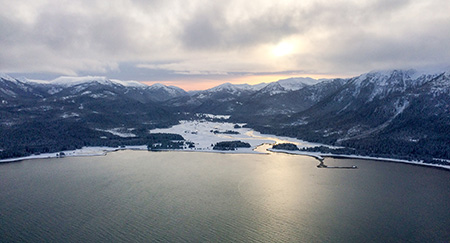
Snow blanketed the mountainous landscape of Southeast Alaska that December. Bare spots existed, but only where the shore met the sea, where the high tides had washed the beaches black and clean. On my five-foot two-inch frame, the snow in the meadows reached my thighs. Deeper in the forest, under the canopy of old growth spruce and hemlock, the drifts brushed my boot tops.
It was there I found the deer.
I stalked the multiple sets of fresh tracks in the snow, glancing down, then up, then right to left. Many animals had moved through moments ago. Four deer, maybe. At least one was large enough to leave deeper, much more defined tracks than the rest.
Glancing up from the tracks, movement caught my eye. Out from behind the thick trunk of a spruce stepped a doe. She was broadside to me, her ears tilted my direction. I froze. The doe stood on the precipice of a steep slope, and I could see her back was blanketed with a layer of snow, like the saddle pad on horse. Her body was tense, but she continued moving cautiously, obviously trying to conserve energy. The struggle to weather this winter storm was beginning to take its tool.
Only four days earlier, rain pelted these woods. It fell in thick sheets, blown sideways by the westerly winds that tend to sweep inland from the outer coast of this region.
Our hunting party of five had arrived by float plane which, besides by boat, is the only way in and out of our winter hunt camp. Nestled in a hidden cove on Chichagof Island, the camp consists of modest cabins which serve as reminders of decades past — tiny, one-room structures with basic bunks, oil stoves, propane lamps, sagging couches and orange linoleum flooring, matched only by the marigold-colored cabinets. On the outside, molds and lichens seem to have climbed up every inch of siding, rooftops struggle to shed moss and spruce needles, winds and earthquakes have rattled foundations to such a degree, it’s hard not to ponder how the structures continue to stand tall against the elements and the ever encroaching rainforest.
Upon arrival we wasted no time organizing gear and supplies before the last of the winter light faded. Once darkness fell, the party — which consisted of three men and two women, including myself — chatted, played cribbage and raised more than a few toasts in approval of the next days’ plans. We decided the group would split and hunt through a series of muskeg meadow systems above the cabins. With little snow on the ground, the deer would be high and these areas had proved productive for Sitka black-tailed deer in the past.
Hunting partners Jeff Mondragon and Stephanie Sell aimed straight up that next morning. They tackled a trail that winds up what we lovingly dubbed “Suicide Hill.” It’s not pretty, but it gets a hunter into some of the best meadow systems I’ve ever seen — and it does so quickly.
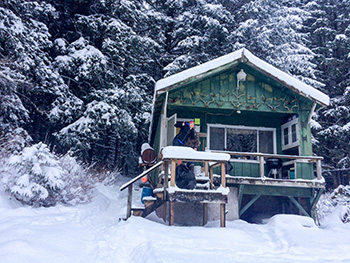
I decided to hunt with my spouse, David, and his longtime hunting partner, Mike Sturrock. Our goal was up a drainage to the south of Suicide Hill. The hike was longer, brushier but a bit more protected from the elements. The rain had let up only slightly, but the winds had calmed from a roar to a purr.
We broke out into the first meadow no more than 45 minutes after leaving the cabin. The meadow was shaped like a large “V” and we emerged at the base. In whispers, we decided to fan out — I would hike left, David up the middle, and Mike to the right. Within moments, we all had our scopes on a buck who stood up from its bed. David shot first. The buck dropped, and we all hustled uphill to help. The shot was placed with precision.
“I can handle this, guys,” David said. “There’s deer in these hills. Go ahead.”
Mike looked at me and shrugged. With David tending to the downed buck, we hiked upward.
About 15 steps later, Mike motioned to me. With his middle and forefinger he gestured to his right, and made the sign for antlers on his head. I nodded. But he persisted. He wanted me to take the shot. I shook my head. He was closer; it was his.
And so he dropped to one knee, and within seconds, a boom rang out. It echoed through the valley. My heart pounded, my adrenaline surged and I saw a large set of antlers on the fringe of the meadow drop to the ground.
Mike turned around the grinned. I gave him a thumbs-up, and glanced uphill. There, at the top of the meadow was a third buck. It stood stock still, but we’d already spied it.
This one was mine. I dropped to my knee, but the movement spooked it. It turned tail and disappeared into the blueberry bushes lining the meadow.
Mike hiked over, and we decided to continue in pursuit. He’d come back soon to dress his kill, but this animal was too good to let get away.
Our efforts to track the animal persisted for a short time, but this buck was feisty, determined, and not afraid to lead us along the steepest of terrain, through the thickest of shrubbery. This day was going to be the buck’s day, not the hunter’s.
I knew of a trail, one that we weren’t far from once we abandoned tracking the third buck. Mike agreed to follow me, and up we went. I settled into a fast pace, knowing a downed animal needed dressing, and a meadow at the top of the grade was our best bet for more opportunities.
The meadow sat at the snowline. Since fall, at least two feet of snow had fallen at the elevation, and moving quietly became more difficult and cumbersome. The rain saturated two to three inches of the crust. The snow was punchy and slick. Again we split up, working around the sides of the small, oval-shaped opening.
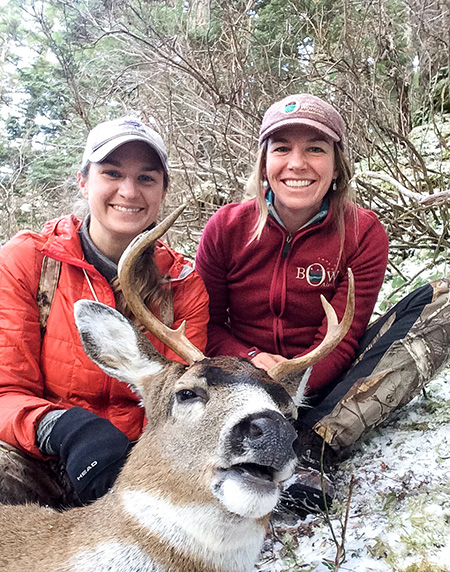
Ten yards in I saw Mike stop. He was looking at something ahead of us intently. He raised his scope. He lowered it. And then, without looking at me, he pointed.
I gazed ahead, squinting. I took half a dozen steps into the center of the meadow. That’s when I saw it: The dark silhouette of two ears, and a triangle-shape face looking at us. The doe was bedded down under a shore pine, with a nice overlook of the larger meadow below her.
Slowly, I lowered myself into the snow, raised my right knee to my shoulder as a brace, and brought up my gun. Through the crosshairs, I could see her. I lowered my gun and took a breath. And I stared at her. She stared back. I raised my gun again, found her in my sights, exhaled, and squeezed the trigger.
The bullet hit where I wanted, and the kill was clean.
“Nice shot!” Mike said.
I took a deep breath and smiled. It was only then I noticed my shaking hands, still quivering from the adrenaline. No matter how many times I hunt, fish or practice at the range, the excitement is always the same.
We hustled through the meadow and the deep snow, down a ravine and back up the other side to find her still in her bed.
Mike continued on past, and began to glass the meadow below for spooked animals. I knelt next to her and put my hand on her neck.
I was thankful. I’m not sure exactly how others react to the killing of a larger animal like a deer, but for me, there are always pangs of remorse. Up close, it’s easy to appreciate how brilliantly these animals are adapted to survive in the wild. Her thick winter coat, consisting of hollow, heat-trapping hairs was the color of light oak; it had replaced her lighter-weight, rust-colored coat months ago. Long eyelashes protected her eyes from rain, snow and shrubs. Her ears, hugely adapted to hear even the faintest of forest sounds, dwarfed her head. I felt her shoulder. It squished like melted cheese. She was in good health; there was a thick layer of fat that would have surely helped her survive the winter ahead.
Mike was next to me again. We couldn’t wait any longer. It was time to dress her and keep moving. What he didn’t know, was this was my first Sitka black-tail deer.
“What?!” he said. “That’s awesome! Congratulations! I had no idea.”
I just smiled.
While this may have been my first black-tail, it was nowhere near my first hunt. Years ago I took a 6-point bull elk in Montana, and have spent many hours in the woods of Southeast Alaska on the trails of deer since. Time in the woods is time well spent. And this time it had paid dividends.
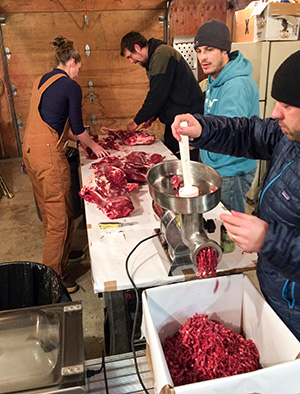
I knew how to gut a deer, but I had never done so on a freshly killed animal, only the partially frozen specimens I’d practiced on in a Deer Field Dressing class. And so, Mike talked me through it, and loaned me his superbly sharp knife that shaved many minutes off the tedious task. He even loaned me his drag rope (an absolutely necessary item I had never heard of until that moment).
We secured it around her neck, and that was when the real work began. Within two steps I was on my face. The doe had barely budged. Mike grabbed a hoof and together we hauled in fits and starts back toward the edge of the meadow where we had emerged.
Suddenly, Mike stopped.
“Did you hear that?” he said.
I shook my head. He pointed to my left. Movement in the bushes seemed to be coming toward us. My heart began to pound. Bear? Another deer?
“Hey you guys! Congrats, Ab. You got one!”
It was David. He had finished dressing his animal and hiked toward the shot. With another body to help with the hauling, Mike bid us adieu and bounded down the trail to tend to his animal.
What I learned that morning about dragging a deer through the rainforest was memorable. First, deer hair really does slide over most surfaces. Sometimes, however, too easily. Far too often the heft of the deer nearly took me down steep hillsides and into ravines. That led to the second lesson: When to let go of the rope! Third lesson: Sometimes, hills and ravines were a friend, so to speak. At the top of a decent grade I’d release the rope, and let gravity take the doe downhill. One downside to this technique became evident rather quickly, however, as the animal seemed to roll into every single root wad, wedge under every single rotting log, or get snagged somewhere on the way down. Fourth lesson: Extracting the animal out of aforementioned root wad, rotting log or off a snag was about as fun as trudging through a patch of Devil’s Club.
About an hour later, we dropped the three deer on a rocky beach. Mike hiked back to the cabin to grab a skiff.
Standing in the now steady rain, my adrenaline began to wear off, my body, hot and sweaty from the effort, began to cool. I realized I was completely soaked; my three layers of wool were cooling and I began to shiver.
The 10 minutes it took Mike to arrive with the skiff felt like 45, but after we loaded the deer a nip from his flask helped me forget the chill.
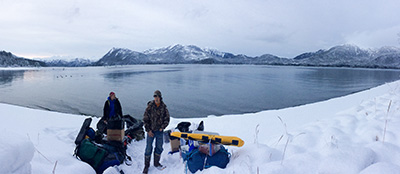
That day, Sell and Mondragon came back empty handed, but not without stories of “the one that got away.”
Four days later, I stood in the tall timber looking up at the doe standing in deep snow. Winds blew huge tufts of snow off tree limbs, and clouds dumped snowflakes the size of quarters onto the landscape.
How things had changed in such a short time. And, due to the weather, we had been stuck at the cabin for three unexpected extra days.
I didn’t have a rest, and the shot was up a steep grade. I squeezed the trigger and missed. The deer bounded off. I kept climbing, following the tracks easily despite the falling snow. Minutes later, I reached a huge area of downed trees, each one lying over top of the other. As I climbed up and over, under and around I saw him. The larger of the tracks I was following belonged to a buck standing 50 yards directly in front of me, broadside and stoic. I found a log for a rest, brought up my sights and pulled the trigger. As I did, a huge tuft of snow fell in front of the buck from above. For a few moments all I saw was a plume of white. When it cleared, he was gone. I hurried over to where he had been standing, only to see his tracks moving away. Muttering an expletive under my breath, I turned around.
“How could I have missed?!” I thought.
I looked up again. Standing 20 feet away was a small buck. This time I didn’t miss.
He was dressed and secured within 20 minutes and I made my way back down the steep, snow-covered slopes with difficulty on my own. The snow made dragging exceptionally easier, but the deep powder made footing uncertain, and the heft of the deer pulled me down grades I didn’t want to explore. Still, I made it to the beach where the rest of the party was waiting.
“Just one?!” they joked. “We thought you’d come out dragging two or three animals!”
I smiled. This little buck was plenty for me to handle on this day.
A day later our float plane arrived. We had to order a larger plane, an Otter, to haul back our harvest. Flying through broken clouds and sun, it was hard to leave our tiny cabins behind, and the deer that continued to hide in the woods.
But hearts were full, and memories were made.
Winter hunting in Southeast Alaska, whether in rain, snow or sleet, can be a productive endeavor. As with any expedition there are many stories to tell. This one is just one of many.
Abby Lowell is a contributing writer to Alaska Fish and Wildlife News and serves as an education specialist with the Alaska Department of Fish and Game’s Division of Wildlife Conservation. She is based in Juneau.
Subscribe to be notified about new issues
Receive a monthly notice about new issues and articles.
